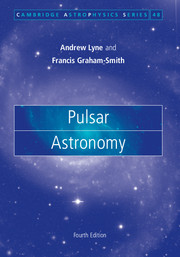Book contents
- Frontmatter
- Contents
- List of illustrations
- Preface
- 1 The discovery of pulsars
- 2 Neutron stars
- 3 Telescopes and techniques
- 4 The distances of the pulsars
- 5 Pulsar timing
- 6 Timing and astrometry of binary pulsars
- 7 Timing irregularities
- 8 The Galactic population of pulsars
- 9 The Crab and Vela Pulsars
- 10 Other young pulsars
- 11 Millisecond and binary pulsars
- 12 Accretion-powered X-ray pulsars
- 13 Magnetars
- 14 Supernovae and their remnants
- 15 Integrated pulse profiles
- 16 Individual pulses
- 17 Location of emitting regions
- 18 Radiation processes
- 19 The emission mechanisms
- 20 Interstellar scintillation and scattering
- 21 The interstellar magnetic field
- 22 Achievements and prospects
- References
- Index
8 The Galactic population of pulsars
Published online by Cambridge University Press: 05 March 2012
- Frontmatter
- Contents
- List of illustrations
- Preface
- 1 The discovery of pulsars
- 2 Neutron stars
- 3 Telescopes and techniques
- 4 The distances of the pulsars
- 5 Pulsar timing
- 6 Timing and astrometry of binary pulsars
- 7 Timing irregularities
- 8 The Galactic population of pulsars
- 9 The Crab and Vela Pulsars
- 10 Other young pulsars
- 11 Millisecond and binary pulsars
- 12 Accretion-powered X-ray pulsars
- 13 Magnetars
- 14 Supernovae and their remnants
- 15 Integrated pulse profiles
- 16 Individual pulses
- 17 Location of emitting regions
- 18 Radiation processes
- 19 The emission mechanisms
- 20 Interstellar scintillation and scattering
- 21 The interstellar magnetic field
- 22 Achievements and prospects
- References
- Index
Summary
The surveys
A glance through the catalogue of known pulsars shows at once that they are mostly found in the Milky Way. The normal pulsars show the clearest concentration towards the plane of the Galaxy, while the millisecond pulsars, most of which can only be detected at smaller distances, are more isotropic. The normal pulsars must therefore be young Galactic objects, and it might be assumed that their distribution through the Galaxy is similar to that of young massive stars and supernovae. Although this is nearly correct, it can only be established by reading the catalogue in conjunction with a description of the surveys in which the pulsars were found; many of these surveys in fact concentrated on the plane of the Galaxy, giving an obvious bias to the catalogue, while others show considerable variations of sensitivity over the sky.
The first surveys to cover large areas of the sky were comparatively insensitive, and necessarily gave rather meagre evidence. For example, Large & Vaughan (1971) found only 29 pulsars in 7 steradians of the southern sky. Nevertheless this catalogue, combined with a northern hemisphere catalogue covering low Galactic latitudes (Davies, Lyne & Seiradakis 1973) showed that there must be at least 105 active pulsars in the Galaxy.
There are now nearly 2000 known normal pulsars, over half of which have been discovered in surveys carried out at frequencies near 1.4 GHz (see Chapter 3). The entire sky has now been surveyed to a reasonably well calibrated flux density limit, both for normal pulsars for millisecond pulsars, while surveys with greater sensitivity cover low Galactic latitudes.
- Type
- Chapter
- Information
- Pulsar Astronomy , pp. 105 - 116Publisher: Cambridge University PressPrint publication year: 2012

